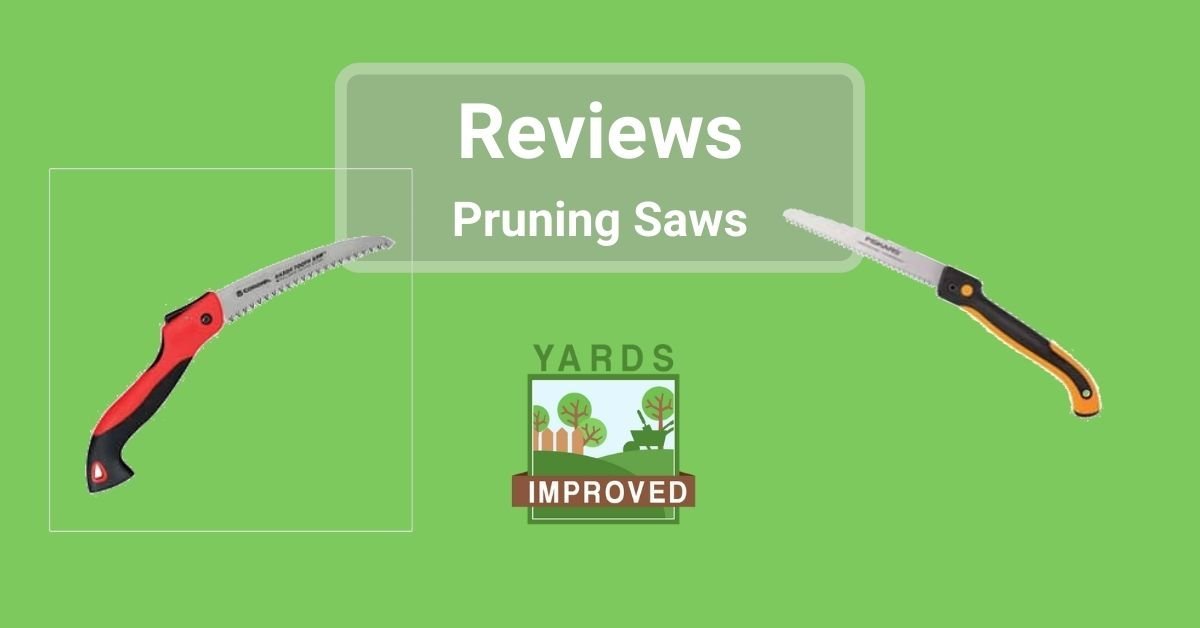Have trees on your property? At some point, you have to deal with a problem branch. Having a pruning saw on hand makes it a cinch!
Maybe a branch died. Perhaps one is getting too close to a window or hanging over a gutter. It could be blocking a view of your house from the street, creating security concerns.
If that branch is too big to use loppers, you will need a saw. And here, we will look at the right tools for the job.
Defining A Pruning Saw
There are saws for all sorts of things. When we talk about a tree saw, we want to consider ones that are, first of all, designed to cut wood. Also, it needs to reach the branches you need to prune!
Bow saws can be considered tree pruning saws, but we will leave them for another article. Their frame is generally a bit larger than what we are going to cover here.
Some pruning saws fold up and are small enough to be carried in your pocket. Others are a bit larger. And some can be mounted on extension poles so that you can reach branches a bit farther up.
What To Look For In A Tree Pruning Saw
So, what do you need to consider when choosing a pruning saw? There are a few factors and options!
Pole vs. hand
As we mentioned above, some tree saws allow you to attach a pole to increase your range. We think it’s a great option in most circumstances. However, you may not anticipate ever needing that. If you only have thick-limbed bushes or smaller trees that you can prune from a ladder, there’s no need to spend extra on the pole.
In either case, don’t overreach. Use your tool within your normal range of movement, especially if working overhead. Don’t bring a branch down on top of yourself! If you have to stretch, you should be using a different tool or seeking a pro.
For our reviews, we’ve researched three of each of these types.
Folding vs. non-folding
There are models of pruning saw that can fold in half with the blade sheathed in the handle. If you like the convenience of carrying the saw around with you, this is a fantastic feature.
Otherwise, it’s not necessary. If you need a longer saw, you might have a hard time finding a folding one.
Curved or straight
The shape of the blade is mostly a matter of personal preference.
We find a blade with a slight curve can make it slightly easier to keep the blade in place on the branch. It also increases the amount of blade touching the surface by a tiny bit.
However, these are small factors. Go with what you think you’ll feel most comfortable with.
Picking a length
Blade length can be a deciding factor, especially if you’ll be working with trees or bushes that don’t have a lot of space between branches. In that case, you want something smaller so that you aren’t constantly banging into other things.
On the other hand, you don’t want a blade so small that it’s hard to saw with. It should be long enough that you’re not pulling the end of the saw past the branch as you cut.
Think carefully about what pruning you need to do and make your choice based on that.
Our Recommendations for the Best Pruning Saws
Ready to buy a tree pruning saw? We’ve evaluated some of the best on the market. You’ll find two sections here: hand saws and pole saws. Of course, the pole saws can be removed from the pole and used for up-close work, too.
Hand Saws
Corona RazorTOOTH 7 in. Folding Pruning Saw
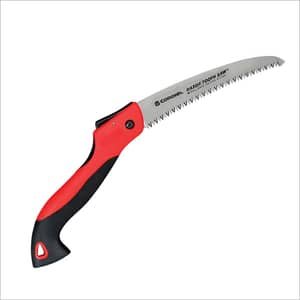
Corona makes wonderful saws. This is one of several high-quality offerings that would be a welcome addition to any shed!
The 7-inch blade and ergonomic handle make using it a breeze. Corona says it’s good for branches up to 3 inches. You could use it on larger branches, of course, but it’s hard to pull this blade length completely through a stroke on something bigger.
It does glide smoothly through most types of wood. It has a chrome finish on the blade which seems to reduce drag.
The handle is 10 inches. Only about an inch of the blade is visible when closed.
Some people with smaller hands say it’s uncomfortable for them to use. It felt comfortable for us, though, but our hands are large.
There’s a lifetime limited warranty on this Corona saw.
Fiskars Power Tooth Softgrip 10-inch Blade Pruning Saw
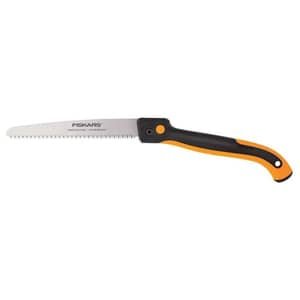

As always, Fiskars comes through with a quality product. In this case, it’s a 10-inch folding pruning saw that works well in any position.
The handle measures 12 inches and is relatively comfortable to hold.
The blade can be locked open in two distinct positions. According to the manufacturer, that’s to make it easier to cut “overhand” or “underhand.” And it does the trick quite well. It’s relatively easy to cut even if you have to hold it with the blade facing up instead of down. Still, it’s an awkward position and causes more arm fatigue. But at least it’s not because of the saw itself! It’s a good feature even if you don’t want to use it too often.
The teeth are 6 per inch on a ten-inch steel blade.
The biggest drawback to this saw is the blade is on the thin side. That makes it hard to handle more than small branches. It will get through anything, but anything over 3-4 inches thick might be annoying to handle with it.
The blade and handle are both durable and should hold up for years with proper care.
Silky GOMBOY 8-inch Folding Saw
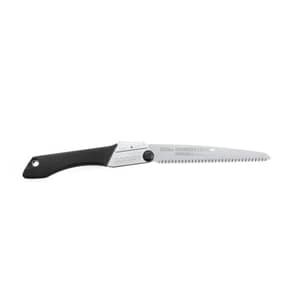

This 8-inch folding saw from Silky does a solid job all around the yard. With it, you’ll soon be cutting branches up to 4 inches without trouble!
With 8.5 teeth per inch, it will produce a clean cut. At the same time, that makes it a little slower. Still, it’s not too bad at working through any type of branches we tried it on.
The handle is 9.2 inches, providing a good amount of space for gripping. It’s made of rubber. The design could be a bit more ergonomic, but it’s not too bad if you are only sawing a few branches.
A clear plastic carrying case is included as well. This is a nice addition to help keep moisture out while the saw isn’t being used.
The lifetime limited warranty covers material and workmanship flaws.
Pole Saws
Notch 15-in. Steel Blade Pole Saw Set
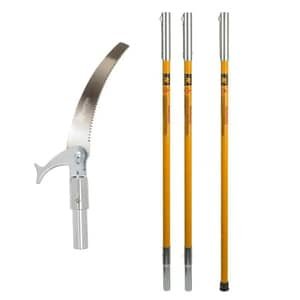

This Notch-brand tree saw has an 18-foot pole that can be separated into three equal sections. The pole is made of fiberglass and is sturdy. It’s also easy to screw and unscrew. Of course, you can always use only one or two sections if you need a shorter tool.
There’s a lot of curve to the blade. That makes it easier to get at branches and pull them down as you try to cut through.
At 15 inches, the blade also can handle larger branches up to perhaps 8 to 10 inches across. Don’t forget to work safely when you’re working with something like that, though!
It’s a quality tool that could probably be considered professional grade. If you have branches to trim a bit further up, you’ll appreciate this saw!
There’s a lifetime warranty that covers workmanship and material.
DocaPole 7 ft. to 30 ft. Extension Pole + GoSaw Attachment
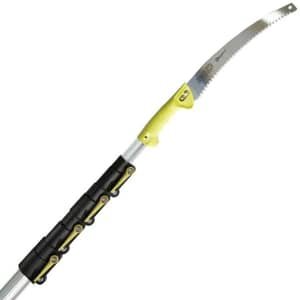

Docapole offers this saw with an extension pole. It gives you a great range of sizes from 7 feet to 30 feet. And as an extension pole, you have a lot of flexibility about how long you want it to be.
You lock it to the appropriate length with simple thumb levers. There are rubber grips to make it more comfortable and prevent slipping.
The pole is made of aluminum. That makes it lightweight. Yet it still seems sturdy enough to get the job done. The company recommends using it at a maximum of 28 feet so that it doesn’t flop around. Obviously, the more you extend it, the less control you’ll have over it.
There are a good number of complaints that the sections don’t stay in place, either. The locks don’t always seem to hold well. Some people even had them pull apart – leaving the blade stuck in a cut and part of a pole hanging in the tree!
The blade is 13 inches and has a slight arc to it. That does help it cut more quickly as it curves around the branch. On Home Depot’s website, the company says it’s good for cutting up to 4-inch branches. We think it does a good job on pieces even a bit more. Six inches might be the max we’d go for.
To keep the blade firmly attached, there’s a locking screw. Another advantage is that you can also use other accessories with the pole. It’s a standard screw-on size.
Hooyman 14-foot Pole Saw


The pole on this saw is shorter than the ones above. But for many homeowners, it’s big enough to get the job done. And the ones above might be for working with cutting far out of your comfort zone!
This one, however, is just five feet long. That’s still considerable reach!
The pole is extendable to 14-feet- Collapsed, it’s about 5 feet. The blade is 13 inches long.
A rubber sheath for the blade is included to help keep it dry. Be sure to clean the blade carefully before storage!
It cuts well and handles 4- to 5-inch thick branches with ease. The blade does a nice job overall.
The pole is aluminum and is of good quality. The clamps used for extending it, though, do tend to slip some. It’s not too bad, and the effect isn’t as noticeable when used with less extension.
Conclusion
Anyone who has trees or bushes to contend with should have a pruning saw among their tools! There will come a time when you need to remove a branch or two, even if you don’t use it regularly. Whether you choose one on a pole or not depends on the size of your tree. But in either case, you’ll be glad to be able to safely remove dead branches or even those that are just in the way!

